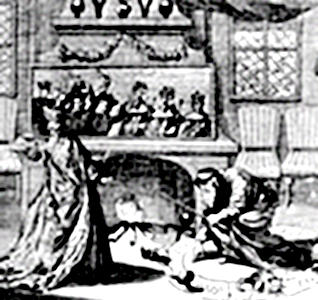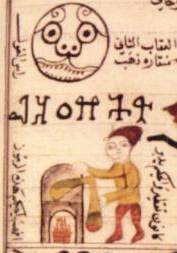Following six years of arduous research, an unnamed 44-year-old German industrial technician has been trying (unsuccessfully) since 2005 to get his/her Voynich theory “De Aqua” published, either as a book or as an article. Frustrated by the lack of progress, last month he/she placed thirty-three sizeable chunks of it onto YouTube.
Of course, I fully understand that a busy person like you can’t really spare the time to trawl through several hours of German-text video presentation. So, to save you the bother, I’ve compiled a great big list of all highlights as seen from my chair [though here’s the final part (#33), which is a visual montage of all the interesting claims from the first 32 parts].
(1) Part #1 sets off with the basic format we’ll see throughout – endless pages of (almost entirely) German text fading in and out on a coloured background. Firstly, the top-level description of the theory gets presented: that the Voynich is actually entitled “De Aqua” (i.e. “concerning water“) and that the EVA transcription “otork” somehow translates as “aqua”. It then lists page after page of late-medieval things related to water. Part #2 asserts the author’s historical conclusions – that the VMs was written between 1525 and 1608 by four authors (in four writing systems), and that the underlying plaintext is German & Italian – before outlining the VMs’ known provenance since then.
(2) Part #3 is a bit of a scattergun attack on the 16th and early 17th centuries, with Kepler, Dee, Kelly, Paracelsus, Sir Francis Drake, Nostradamus, Isabella Cortese (who probably didn’t exist, incidentally), German mathematician Adam Ries, the Church’s Index of Forbidden Books, etc etc all name-dropped in quick succession. Part #4 (only three minutes long, most of the others are closer to ten minutes each) links the three red shapes on f1r to (a) “Astrologie / Astronomie“, (b) “Fauna / Flora“, and (c) “Medizin“. No proof, no evidence, just presented as fact.
(3) Part #5 begins a lengthy discussion of medieval herbals, concluding that f2r depicts Lactuca virosa, f3r depicts a Spanish pepper, that f4v depicts an aubergine (i.e. that the VMs must post-date 1500). Part #6 continues in the same vein, while Part #7 argues that f33v depicts maize (which is where the claimed earliest date of 1525 comes in). Part #8 is broadly similar, lots more of the same.
(4) Part #9 has some nice pictures of things resembling the jars in the pharmacological section (though I couldn’t see references or dates for these?), as well as lots of parallels for details, including a nice little dragon (was this from the same Paris manuscript Sergio Toresella once mentioned?). Part #10 has many more parallels (including the famous “armadillo” [hah!] and the Novara coat of arms, etc), as does Part #11 which again returns to the VMs’ f25v dragon.
(5) Part #12 goes off the rails a bit, with claimed resemblances to body parts; Part #13 covers menstruation and the spongum somniferum (for which Caterina Sforza included a recipe, as I recall), though I can’t make out the yellow annotations to the marginalia on f66r (2:41 into the video); while Part #14 reads f77r as depicting the four elements.
(6) Part #15 gets back on track with astronomical parallels; Part #16 looks closely at the rather strange page f67v2 and proposes that the corner shapes are actually constellations (such as Pegasus); Part #17 goes off on a fairly pointless Giordano Bruno tangent; Part #18 looks at the zodiac pages (including a little discussion on the month names); Part #19 focuses mainly on the month names such as the Leo page (because of its Germanic-looking “augst” month name), though it beats me what Al Pacino is doing in there (4:02). 😮
(7) Part #20 looks at crowns and golden fleeces; Part #21 goes back to the zodiac nymphs, looking more at the structure of the pages, before moving on to discuss the 15th century “De Sphaera” by the deaf Milanese illustrator Cristoforo de Predis, who worked for the Sforza family (ah, them again).
(8) Part #22 (are you still reading this? Just checking!) compares the drawings in Quire 13 with Roman aqueducts and similar water structures; while Part #23 looks at Leonardo da Vinci’s take on water, compares (at 1:21) a detail on f79r with a sextant (Rich SantaColoma recently blogged that the same detail reminded him of early “swimming girdles”, though I suspect neither have it right), and discusses rainbows too. Part #24 discusses water nymph details (poses, rings, cross, horseshoe, spinning top, nail, etc).
(9) Part #25 focuses (rather unsatisfactorily, it has to be said) on various tenuous links with alchemy, with the only high point being the comparison between the balneo section’s “giant grapes” page (f83v) and a page in Das Buch der waren Kunst zu distillieren (1512).
(10) Part #26 is pretty thin apart from a fascinating parallel (0:53) between a detail of f76v and a drawing of Mercurius in Liber II of Giordano Bruno’s (1591) De Imaginum Compositione; Part #27 is even thinner; while Part #28 proposes that the nine-rosette page is a map of Italy with Venice in the middle (yes, I’d say) and Pompeii in the top left (no, as it was only rediscovered in 1748). [I’m not convinced by Valdarno and the Wasserturm, either.]
(11) Part #29 (Perfume and Plague) didn’t really work for me at all; while Part #30 (Hidden Characters in the Manuscript) only briefly gets interesting when looking (1:53) at similarities between our beloved MS408 and Medeltidshandskrift 47 (at Lund University in Sweden) – the discussion of the f17r and f116v marginalia seems superficial and unconvincing to me.
(12) Finally, in Part #31, our anonymous author gets to the point of his whole book – that (unless I’ve misunderstood him/her, which is always possible) some clever computer programmer out there should be able to make use of all the clever cribs he/she has amassed as a result of his/her long journey into the heart of the VMs’ pictures. Part #32 has his/her (fairly diffuse, it has to be said) bibliography; and Part #33, as mentioned above, is a sequential montage of all the visual identifications proposed in parts 1 to 32.
Quite why neither of the German Voynich E-bloggers (hi Elmar, hi Elias) has yet blogged about this I don’t know (perhaps they’re on holiday?): but from where I’m sitting in the UK, there’s plenty to say about it.
Firstly, it is pretty clear that the author has for some years sustained an intense (and independent-minded) assault on the VMs’ pictures – yet at the same time he/she seems quite unaware of many long-running problematic debates, such as the whole “heavy painter” issue. Had the plant on f4v not been overpainted blue, would his/her identification with “aubergine” have been so clear-cut?
In addition, while it’s fantastic to see someone wise to hidden details (such as the concealed people in f86v4, even though this is mislabelled as f68v4 in Part#7), overall I just don’t accept the idea that the VMs’ plants can be identified as solidly as he/she thinks – we’ve now had three or four generations of herbal researchers look at it, with each finding it bewildering in a new way. Furthermore, comparing drawings with modern plants (or even with interpretative drawings of modern plants) is of little use, as virtually every plant you can name has been extensively adapted and altered over the centuries by, ummm, cunning breeders.
While I’m sympathetic to the author’s project and research programme (it is, after all, more or less identical in intention to what I was trying to do with my own “The Curse of the Voynich”), where it falls down is in historical methodology: in this instance, you just can’t get the level of proof you would like from visual similarities, however many of them you try to amass. Has our unnamed author provided coherent and powerful evidence supporting the identification of MS408 as “De Aqua“? I don’t really think so – plants aside, the overwhelming bulk of the discussion is fairly lightweight, and does not gain any real traction on the real history of the manuscript despite the sheer mass of intertextual references.
All the same, there’s plenty of food for thought here (though I wish many of the manuscripts where so many of the nice illustrations were taken from had MS and page references to back them up) – but for all “WilfridVoynich“‘s hard work, the end result simply fails to produce the set of cribs he/she was aiming for. Sorry, but it’s not “De Aqua” as claimed (though, to be honest, I would be hugely unsurprised if the vertical column of letters on f76r does indeed somehow encipher “de aqua”).
The end result, though, is plainly a great personal achievement – and I would be delighted if some of the intriguing and bold visual connections he/she has drawn in it ultimately lead onwards to genuinely productive and useful future research within the overall VMs community. For all its faults and limitations, this is definitely the (virtual) Voynich book of the year for 2009! 😉


